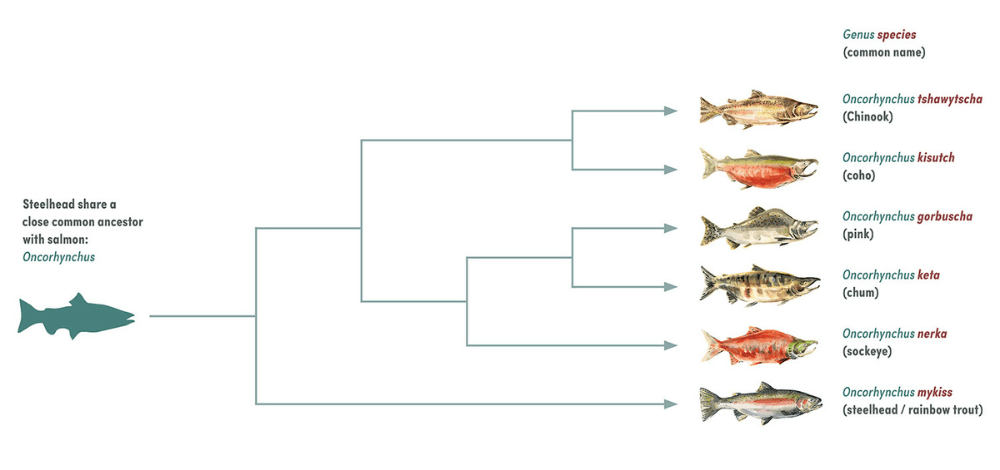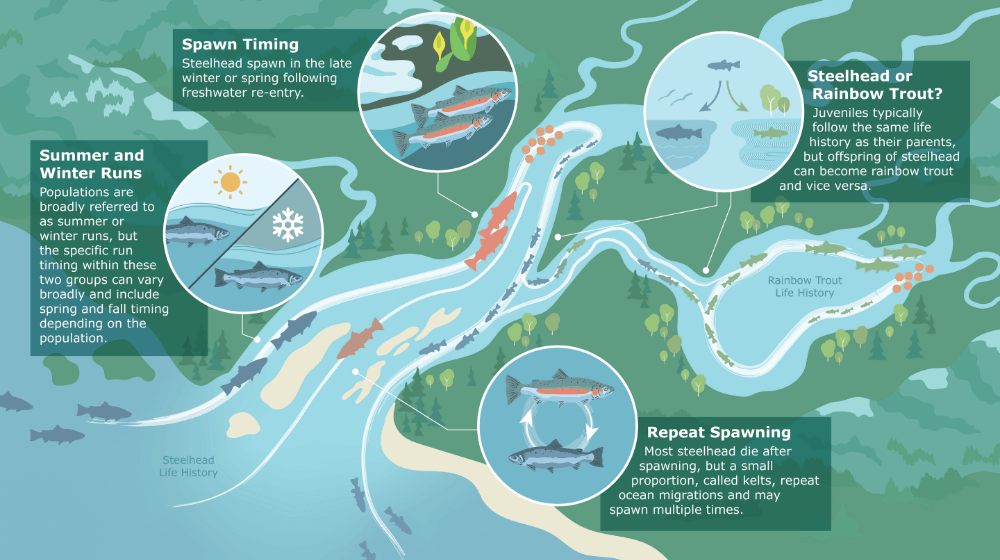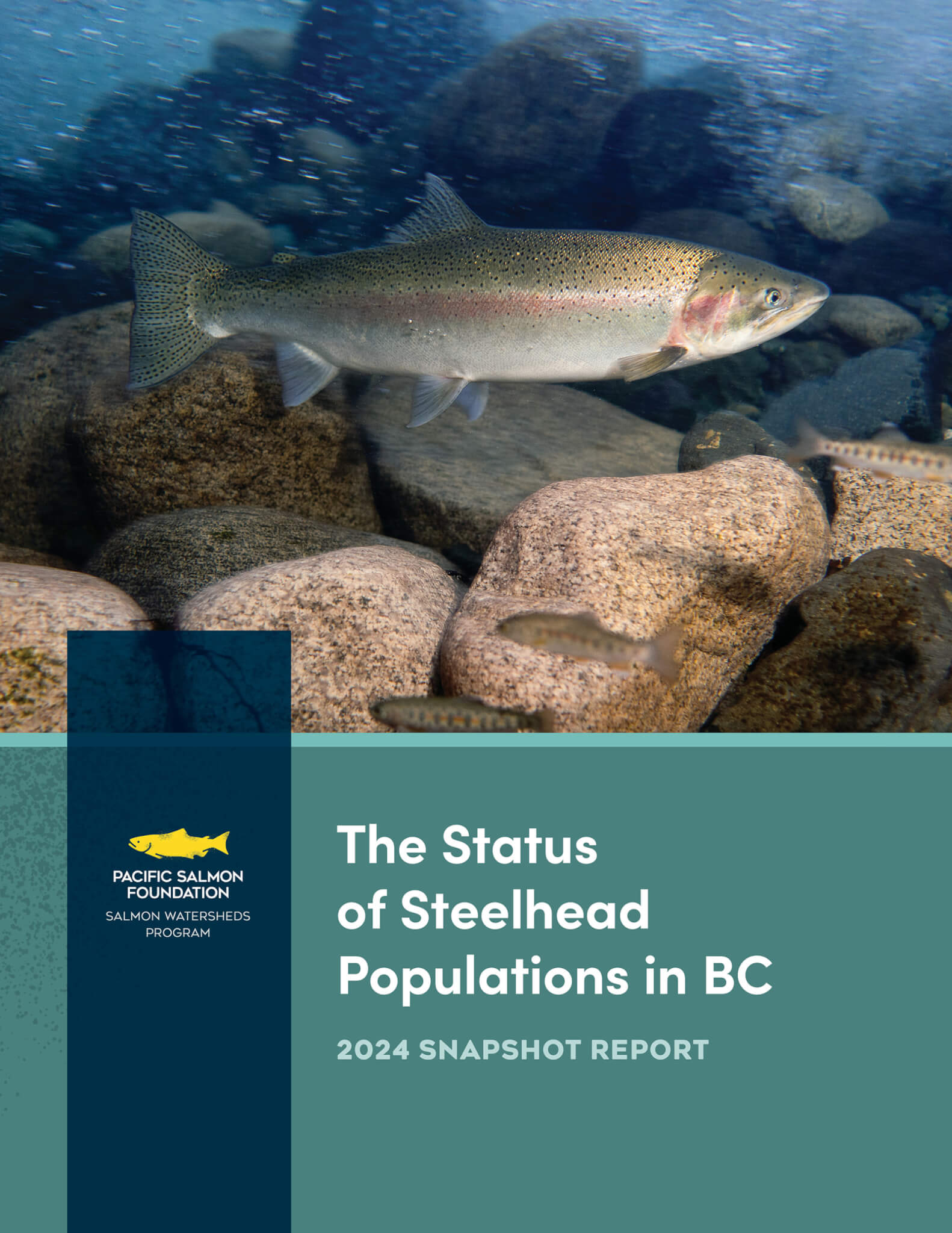Steelhead data reveal major conservation concerns across B.C.
Jan. 31, 2024
The Pacific Salmon Foundation has released new datasets and a report outlining the poor status of most British Columbia steelhead and recommending urgent actions.
New status assessments for steelhead populations in British Columbia highlight conservation concerns for the iconic fish species. The Pacific Salmon Foundation (PSF) has published these province-wide assessments in the Pacific Salmon Explorer, an online tool that provides free access to comprehensive data for salmon, and now steelhead.
Of the seven population groups with sufficient data available, none were assessed as “good” status. The vast majority (six) had “poor” status and one is classed as “fair” status. It was only possible to assess 19 per cent of steelhead population groups in the province given the available information.
While the decline of some steelhead populations (e.g. interior Fraser steelhead) has been well-documented, these new assessments reveal the poor status of other steelhead populations based on the best-available estimates of adult steelhead abundance.
“Compiling and centralizing the data allowed us to shed light on the poor state of steelhead populations across the province,” says Katrina Connors, Director, PSF’s Salmon Watersheds Program.
“There is a window of opportunity to catalyze future efforts and investments to improve steelhead monitoring in B.C., address conservation risks, and work more collaboratively towards both ends.”
Steelhead are a culturally and economically significant species for many groups in British Columbia and provide important ecosystem benefits, including the transfer of marine nutrients to terrestrial habitats as they return to their streams.
“Steelhead have significant cultural, economic, social, and ecological importance to British Columbians. I welcome PSF’s inclusion of steelhead data on the Salmon Explorer tool that will increase public access to data on this iconic species. Together with the Government of Canada, B.C. contributed $15.15 million last December to support five new steelhead projects through the British Columbia Salmon Restoration and Innovation Fund and continue to work with partners like PSF to support wild salmon and steelhead,” says Hon. Nathan Cullen, Minister for Water, Land and Resource Stewardship and Minister Responsible for Fisheries.
These findings highlight that major investments in steelhead monitoring, assessment, and recovery are urgently needed. PSF’s new report, ‘A Snapshot of the Status of Steelhead Populations in B.C.’, contextualizes the data and offers recommendations on how to work toward these goals.
Centralized data enables province-wide steelhead conservation
Monitoring is the foundation of steelhead assessment and conservation. Without data, it is challenging to assess conservation risks and act on conserving this unique species.
Presently, only 19 of the estimated 429 steelhead populations in British Columbia, or 4 per cent, have publicly available data on the number of adult steelhead returning to their streams within the last 10 years.
Although long-term steelhead monitoring programs exist in some regions of British Columbia, major data gaps hinder efforts to identify and implement the appropriate conservation and recovery strategies. This could lead to “silent” extinctions of unique steelhead groups across the province.
These independent status assessments — funded through the British Columbia Salmon Restoration and Innovation Fund, a joint initiative by the Government of Canada and Province of British Columbia — reinforce the need to expand baseline monitoring to prevent further steelhead declines and support steelhead resilience.
To this end, PSF’s report on the state of steelhead in B.C. recommends Crown and First Nations governments, non-profits, and academics commit significant funding and resources to steelhead monitoring to assess, and manage, conservation risks.

This evolutionary tree shows how steelhead are related to Pacific salmon. Credit: Fuse Consulting Ltd.
The outlook for steelhead in B.C.
In recent decades, steelhead populations across the coast have experienced low survival rates in the ocean, likely due to multiple factors, including warming temperatures as well as increased predation and competition. Mixed-stock fisheries that target salmon can also intercept steelhead, introducing conservation risks for some steelhead populations. Moreover, declining steelhead abundances have been linked to changes in their freshwater habitats due to human activity, such as logging and water use.
These factors can interact to threaten the survival of steelhead populations. For instance, in the Chilcotin River in B.C.’s southern interior, only 19 steelhead came back to spawn in 2022, compared to more than 3000 spawning fish reported in 1985. The Committee on the Status of Endangered Wildlife in Canada (COSEWIC) assessed these interior Fraser steelhead as Endangered in 2020, meaning they are now at risk of extinction.

Steelhead are genetically identical to rainbow trout but share many similarities with Pacific salmon. Credit: Fuse Consulting Ltd.
Over the last two years, PSF’s Salmon Watersheds Program has aimed to support steelhead conservation by centralizing the best available data in collaboration with First Nations, federal and provincial governments, academics, and independent steelhead experts.
Dr. Eric Taylor, Professor of Zoology at the University of British Columbia and former chair of COSEWIC, has been involved in this collaborative effort.
“The inclusion of British Columbia’s iconic steelhead trout in the Pacific Salmon Explorer represents a critical advancement in the public availability of scientifically defensible information on the conservation status of, and threats to, this close relative of Pacific salmon,” says Dr. Taylor.
“Arguably at the greatest risk among all species within the Pacific Salmon Explorer, data-driven summaries on the status of steelhead trout will greatly enhance our shared goal of conservation and recovery of this magnificent fish.”
Like Pacific salmon, steelhead are ecologically and culturally invaluable. It will take dedicated and sustained efforts at all levels to address the lack of monitoring and implement meaningful conservation measures to improve the outlook for steelhead in British Columbia.

Read the report, ‘A Snapshot of the Status of Steelhead Populations in B.C.’, to find background context, a summary of key findings, and recommendations related to the status of steelhead in British Columbia.
ABOUT THE PACIFIC SALMON EXPLORER: the Pacific Salmon Explorer is one of the most comprehensive sources of data on salmon – and now steelhead – in B.C., with assessments for 90 per cent of salmon across the province. PSF’s Salmon Watersheds Program has been collaborating with First Nations, federal and provincial governments, academics, non-profits, and independent experts for more than a decade to identify, assemble, analyze, and present the best available data for salmon and steelhead in British Columbia.
MEDIA INQUIRIES: Please contact Braela Kwan, Communications Specialist, Pacific Salmon Foundation, bkwan@psf.ca, (604) 664-7664 ext. 1025





